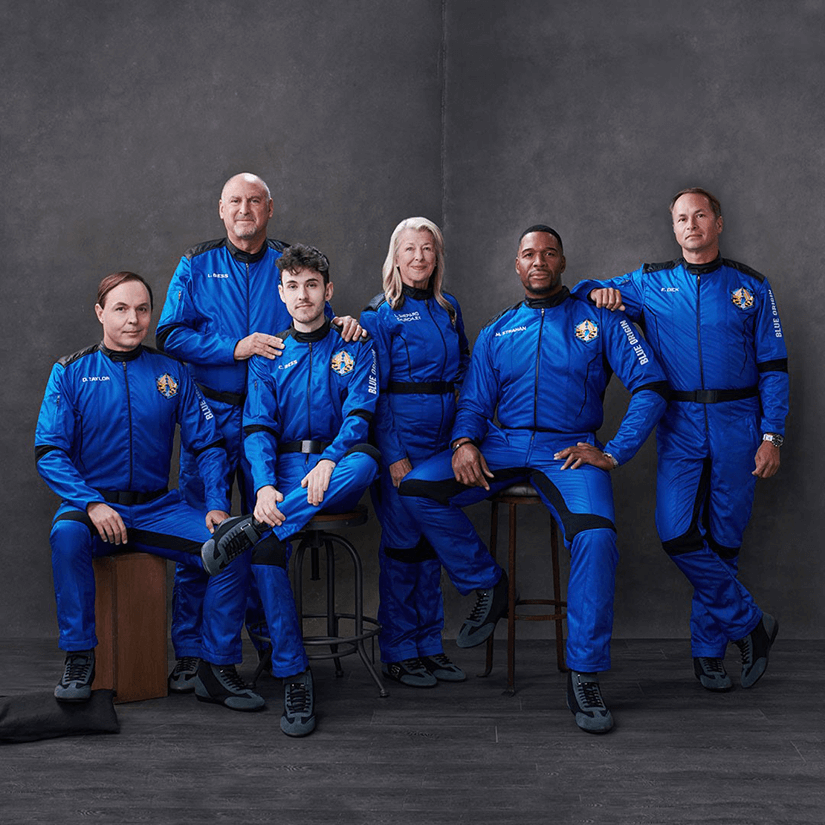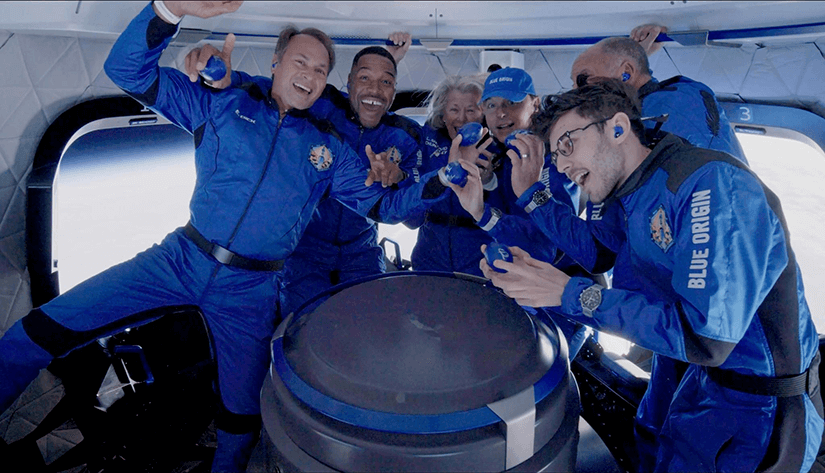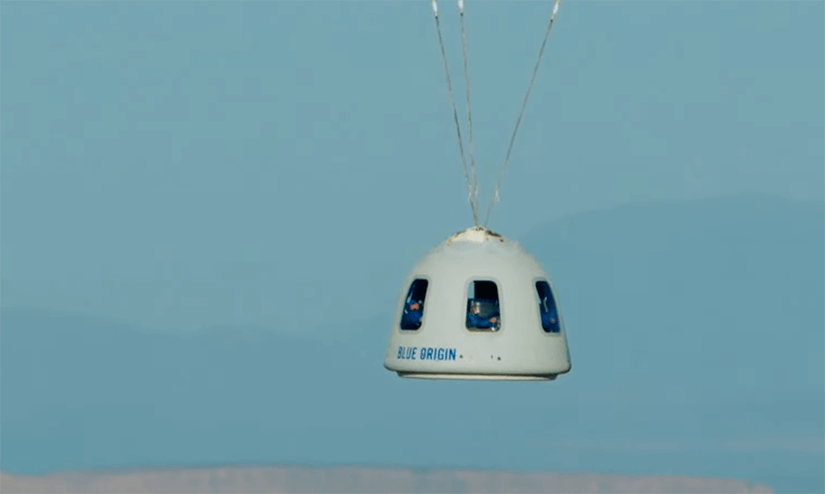StarMan and Life Member Dylan Taylor Just Got Back from Space. (He Recommends the Trip)
Humanity could benefit from the rarified perspective, says space industry exec with grander plans

Denver Mensa’s Dylan Taylor has earned his proverbial astronautical wings. After his recent trip to space aboard one of Jeff Bezos’ rides, that much was assured. But even before Blue Origin’s New Shepherd spacecraft blasted off from West Texas on Dec. 11, only its third crewed flight, the bona fides that landed Dylan a seat on the stubby-shaped ship speak to his promising position in the private space business.
Dylan was one of four paying customers on the six-person flight. (And don’t ask how much because he’s not allowed to say. And don’t try to figure it out because reported prices vary frustratingly from upwards of $500,000 to the winning $28 million bid for a seat on the first flight.) Also aboard the third Blue Origin flight with Dylan were Laura Shepard Churchley, daughter of the first American in space, Alan Shepard, and NFL star turned TV personality Michael Strahan. It’s exclusive company, even without the added “Good Morning America” fanfare. If Dylan had any sort of inside track onto the flight, he chalks it up to his position as CEO of Voyager Space Holdings Inc., which is helping build the next International Space Station, among other out-of-this-world endeavors.
Dylan’s best off-planet achievements might still lie ahead. He outlines those ambitions in a chat with Mensa Bulletin Editor Chip Taulbee as well as recounting 11 of the most exciting minutes of his life as one of Earth’s earliest private space travelers.

Chip: How did you get started in the process with Blue Origin?
Dylan: In March, I participated in the Blue Origin auction, and we were invited to bid for a ticket online. The next step in that process was sort of like the finals, and then it culminated in a phone auction. It was probably April or May when I found out I was not selected. Then [I was asked], “However, would you like to fly with us in the future?” One-hundred percent, yes, I said! I was thinking 2025 or something, a few years in the future. Over time, as I got to know the Blue Origin team, they kept referring to, “Well, you might be on flight nine.” Then later it’s seven and six and five…. I ultimately found out in September that I was flying in December.
Besides a willingness to pay, why do you think you were chosen for such an early flight?
It probably has a lot to do with me being in the space industry. In addition to my day job running Voyager Space, I also founded a nonprofit, Space for Humanity, which is about democratizing access to space.
So was your trip to space for business, for pleasure, or a little of both?
I mean, I enjoyed it; it was a pleasure in that sense. My company didn’t pay for it. I paid for it myself. It’s hard to answer because I don’t think I would have been selected on that flight had I not been an industry insider, if you will. So in that sense, it was for business. But it’s been a lifelong dream for me, so in that sense, it was definitely a pleasure trip.
It’s worth noting that you paid for yourself but also funded a future astronaut’s trip. Still, some critics of these early trips to space have characterized them as boondoggles for the rich. Others have defended them as valuable investments in nascent technology that will ultimately benefit humanity. What’s your perspective?
I think a lot of the criticism has to do with, as I understand it, that we have problems here on Earth, so why squander the resources going to space. I totally agree with the underlying premise. I’m definitely in a camp that says we’ve got real challenges: climate change, income inequality, threats to institutions of democracy. There’s a long list of things. However, I believe those challenges persist and seem intractable because we just don’t have the right perspective.
Part of my belief in the power of space is that it has the ability to transform because you get out of the fishbowl, and you understand we’re all in this together. We’re on this little, fragile, very vulnerable blue marble that’s one bad day away from not existing. I believe space opens this horizon and that the more people we get up there, the more perspective we’ll have to actually solve these problems in that thoughtful way, instead of, you know, basically a food fight, which is what we’re in right now.
Let’s talk about the experience of going to space. Could you, as best you can, try to put into words the indescribable?
Life-changing for sure. But the one word that I have thought about a lot recently is transcendent. In the sense that it’s not like anything I’ve ever experienced, and it was so impactful that you can’t help but be deeply affected. I think it also has to do with really seeing things as they truly are. And for me, there was a vulnerability, which a lot of astronauts talk about.
You get to the other side of that line and realize that the universe is huge; and the Earth is like a point and probably 25 zeros of 1 percent of the universe. And everything outside the atmosphere is not hospitable; it’s cold, dark, and wants to kill you. And you just have this minuscule oasis. And it strikes you, that vulnerability. We’ve got all our eggs in one basket, and it’s a very fragile basket. And you don’t get that sense being terra firma.
A trip to space would be a crowning achievement for many, but you have a grander vision for space. In fact, if your stated goals for Voyager Space reach fruition, there’s a much bigger story here than about one person going to space. What are your plans?
We are going to build the next generation of infrastructure for space. So, if the last 10 years were about building the elevator to space, if you will, with SpaceX and others, the next 10 years is about destinations. We’ll be building a replacement to the International Space Station. We’ve just been awarded the contract. [In December, NASA awarded Nanoracks, in collaboration with Voyager Space and Lockheed Martin, a $160 million contract to design its Starlab commercial space station as part of the agency’s Commercial Low-Earth Orbit Development program.] We will be doing things like helping us return to the moon. We also have a big component of our business that is ESG-related [environmental, social, and governance], environmentally focused, which is cleaning up space debris; it’s a big issue and getting worse. So those are the three problems we’re looking to solve: destinations, return to the moon, and space sustainability.
What kind of legacy do you want to leave? What’s the impact you personally want to have on the private space industry?
It’s to enable humans to live and work in space. And I’m a big believer that building infrastructure and space can allow us to unlock a lot of the benefits of Earth. Think of Earth as almost a national park, and a lot of the environmental stewardship and all the things that are important to most humans become a lot easier if you can offload some of that infrastructure into space, such asli heavy industry and things like that. Enabling humans to live in space — if I can play some small part in making that happen, that’s a win for me.
Prognosticate, as best you can, the next five, 10, 20 years in space — however far out you’re comfortable going?
Private destinations in low Earth orbit are the next kind of mindblower. And I think that’ll happen, 2027, 2028, something like that. There won’t be hotels; it’ll be more like private laboratories. There will definitely be tourists, but think of it more like a privately owned industrial park. That’s the key next step in the industry. Then the return to the moon, which will happen in the 2020s. Getting the first female boots on the moon — that will happen. Third would be Mars. And I don’t think we’ll land on Mars in the 2020s, but I do think we’ll have some spacecraft that will be kind of the first steps. I think we’ll get one of the [SpaceX] Starships. We’ll probably have an unmanned version of that going to Mars in the 2020s. So those are the next three: low-orbital private destinations, return to the moon, and then some kind of first step toward Mars.
Let’s talk about your journey to space. Start with waking up that morning.
Oh yeah, great, this is fun to relive. So you wake up that morning early, around 5 a.m. And step one is you have a private breakfast with your crew and your plus-ones. I think I had 11 guest slots, and I used them all. They bus them into [Blue Origin’s] Astronaut Village, and you’re able to — I don’t want to say “say goodbye” because that’s the wrong ethos — but you basically give everyone hugs and take pictures, even though it’s still dark out at this point.
Then they take the crews to our astronaut training center, and we get in our flight suits, get the final mission, and ask any additional questions. Then we get in the vehicles, these electric trucks, and they’re pretty amazing; they’re designed to go off-road, which is important to astronaut recovery. We take those to the launch site, and from there it’s a routine we’ve been through and practiced many, many times, which culminates with us climbing up the stairs to the top of the tower. Then we go into the room and get another final debriefing. Then we come out of that room and go and ring the bell, which is [a Blue Origin] tradition and then go to the end of the ramp. Jeff Bezos is there, shakes your hand, a photo-op. And then you move on into the capsule. Jeff comes into the capsule and says a few words of motivation, leaves the capsule, and then they close the door.
Then you’re on mission countdown. We had two separate holds, one five minutes and one a 10-minute hold. Those keep counting down, and we get to T-minus 10. At T-minus 2 you hear the engine roar, but you don’t lift off the pad until T-plus 7. So for about nine seconds, the engines are rumbling, and the whole capsule is orange from the rocket flames rolling across your field of vision, but the clamps are still attached, so you’re just rumbling there. They release the clamps at like T-plus 7, and you fly like a bat out of heck.
So we’re pulling about 3.1 Gs, and it lasts for minutes. It’s crazy. And then at 2 minutes 25 seconds, you get main engine cutoff. And from there you can feel yourself floating a little bit because your velocity is still positive but your acceleration is zero. So even though you’re flying at 3,000 mph, it doesn’t feel like it because you’re no longer accelerating.

Then you do booster separation. They blow the capsule and the booster apart with explosives, and that’s very aggressive and very loud. The booster flies back down and lands, and the capsule is still ascending. But that whole time you’re in zero-G. So you can unbuckle, and you’re floating, but you’re still heading up. Then you reach the apogee, which is about 106 kilometers above the Earth, and you’re looking out the window, and it’s the most unbelievable thing you’ve ever seen. I went to my window and turned myself upside down. You reach the apogee and start falling back down, but you can’t feel that because you are not really accelerating yet. You haven’t reached terminal velocity, and you’re not pushing against anything.
We’re on this little, fragile, very vulnerable blue marble that’s one bad day away from not existing.
There’s about four and a half minutes in zero-G, and then you get a bell that says return to your seat. And at that point you have a minute because if you are not in your seat when the capsule hits the atmosphere , that’s a very bad day. You’re going zero Gs to 6 Gs — and 6 Gs is a ton; it could possibly kill you if you’re standing up — back to 1 G in all in about a minute and 30 seconds. You’re hitting the atmosphere, and you can see the gravity [sensors]; it goes from 1, 2, 3, 4, 5, 6, 6, 5, 4, 3, 2, 1. And the 6 is very aggressive, very uncomfortable.
You get through that, and you feel pretty good, and then you’re free-falling for another maybe 2 minutes, and then the drogue chutes come out; those are basically the guide chutes. Then they deploy the parachutes, and that’s quite loud because they’ve basically blown the doors off to release the parachutes with pyrotechnics; it sounds like explosions. They inflate, and then you’re home free; you just drift back down. And right when you’re ready to touch the ground is when they fire the reverse engines. That’s when you get that huge dust plume, and it looks like you’re landing really hard, but it’s the reverse engine thrust kicking up dust.
You land. And there’s people coming for you in the electric trucks like bats out of heck, but you get time as a crew; we’re all hugging and whooping and hollering. They get there, open the door, you get out, and you have cameras in your face, as you would expect. Yeah, that’s pretty much the journey.

And how long was it from liftoff to landing?
I think it’s 11 minutes. It’s really interesting because they said you feel time dilation/elongation in both directions, and I did. On the way up, it’s about four and a half or five minutes, and it seemed like 30 seconds. Whereas at the top it’s four and a half minutes and seemed like 25 minutes. The way down seemed quick as well. And your brain is just trying to make sense of it, and it’s like you’re getting an error message over and over again because it’s nothing you’ve ever seen or done.
